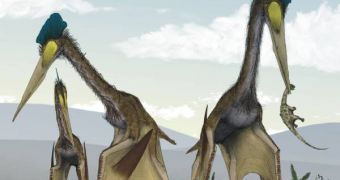Paleontologists have recently managed to uncover a first-of-its-kind prehistoric "runway" for pterosaurs, the ancient, bird-like animals. The tracks, found at a location dubbed Pterosaur Beach, in southwestern France, are the first evidence to show how these animals landed, which is something that is apparently very rare to come by. The main reason for this is the fact that the animal were very light, and did not leave a massive imprint on the ground, such as the largest dinosaurs that ever roamed the Earth, the 50-tonne sauropods, did, LiveScience reports.
The French location proves, however, to have been a very suitable place for recording the landings of the light pterosaurs. Made entirely out of fine-grained limestone deposits, the structure provided the perfect scaffolding on which the feet of the creatures got molded and stored over millions of years. The tracks have been determined to date back to some 140 million years ago, to the Late Jurassic period.
The pterosaur was a pterodactyloid-class beast, with a wingspan no larger than two feet (roughly 60 centimeters). The pristinely preserved tracks managed to provide paleontologists with a remarkable site to study the landing behavior of these creatures, of which similarly well-preserved tracks can be found on only a handful of other locations in the world. The researchers determined that they came in for landing while flapping their wings to slow their descent, and then pushed both of their feet into the sand, at a very high angle.
Next, they took a short “stutter step” while dragging their toes briefly, most likely a hop with both of their feet, and then set their arms down, in the classical, four-legged posture that ancient flying creatures were recently proved to sport while on the ground. “No other trackways ascribed to pterosaurs in the world have shown either landings or takeoffs,” University of California in Berkeley (UCB) paleontologist and researcher Kevin Padian says.
“If tracks from pterosaurs are going to get preserved, it's likely to be in the softest muds or finest sands, and it's unlikely even then, so to get traces of a pterosaur landing like this is very exciting,” David Hone, who is a paleontologist at the Institute of Vertebrate Paleontology and Paleoanthropology of China, in Beijing, adds. He has not been part of the new study.
The most amazing find that the deposit brought forth was the fact that the pterosaurs apparently had a more advanced wing and flapping control than first believed. Pulling a stall in mid-flight would have not been possible with only rudimentary wing control. Continuous research will most likely yield even more interesting conclusions, and the experts have plenty of tracks to analyze. “There are hundreds of trackways in this big quarry,” Padian concludes.

 14 DAY TRIAL //
14 DAY TRIAL //